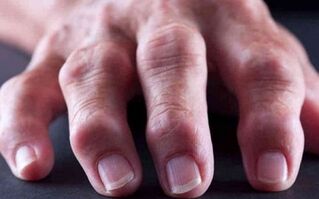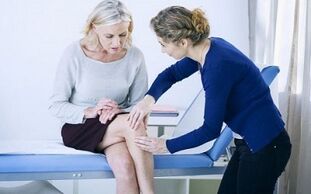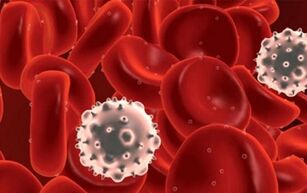
Joint problems often occur locally when a person has pain in a particular joint and can pinpoint the exact location of the pain. But sometimes joint pain cannot be localized, because all or some of the joints suffer at the same time. To say rheumatoid arthritis in this case is too early, because in addition to this pathology there are other diseases that cover the joints of the musculoskeletal system.
A thoughtful doctor will analyze the patient's complaints and identify cause and effect relationships that can determine why all joints suffer at the same time. Confirming a diagnosis is far from easy, and with the most general symptoms, it is not possible to point to a specific pathology immediately, after a series of examinations. Therefore, if you develop generalized joint pain, do not delay your visit.
If all joints of the musculoskeletal system are seriously ill, it could be for the following reasons:
- Pathologies of an autoimmune origin and systemic allergic reactions.
- Rheumatoid arthritis.
- Osteoarthritis.
- Chronic fatigue, increased physical activity.
- Body poisoning.
- Blood diseases.
When pain occurs in some or all of the joints, immediately remember that the condition is a response to certain diseases, not independent diseases. The only exceptions can be conditions such as osteoarthritis and rheumatoid arthritis, when the immediate cause is in cartilage damage.
Rheumatoid Arthritis
Disease refers to chronic autoimmune diseases in which joints throughout the body are affected primarily. A distinctive feature of rheumatoid arthritis is the participation of multiple joints in the pathological process.
At the same time, cytokines, metalloproteinases and chemotactic cytokines play an important role in the inflammatory process. These are anti-inflammatory factors that activate the activity of immune cells of the human body. As a result, they migrate to the site of inflammation, that is, to the joints of the human body, and cause a typical inflammatory response.
The typical manifestation of rheumatoid arthritis is damage to the symmetrical, peripheral joints. As the disease worsens, the pathology affects the larger joints. Pathology affects mainly women, in men it occurs 3 times less. It is diagnosed between the ages of thirty and fifty, but it can also sometimes appear in teenagers - this disease is called juvenile arthritis.
Although scientists have clarified the immune nature of the disease, it is still not possible to determine the exact cause of rheumatoid arthritis - why anti-inflammatory cells are active. pathology like that. To date, a genetic predisposition to rheumatoid arthritis has been demonstrated and it has also been shown that negative factors such as smoking, transmission of viral diseases, etc. appearance of pathology.
The course of the disease is caused by the activation of immune complexes, produced by the synovial membrane and found in the blood vessels. One quick response to them are rheumatoid factors - antibodies that are produced with these complexes. And in some cases, they appear on their own, without the presence of provoking factors.
HELP!In the early stages of pathological development, the macrophages migrate to the affected areas, where after a time the number of lymphocytes increases there. The release of mediators that cause inflammation and stimulate the development of pathological processes throughout the body.
If a chronic damage to the synovial membrane occurs, then instead of the usual thickness, it becomes denser and coarser, growing and forming creases in the form of villi on its surface. . Cells of the synovial fluid produce stromelysin and collagenase, which contribute to the destruction of cartilage tissue. The inflammatory process is enhanced by prostaglandin production, fibrin deposition, and necrosis occurs.
Overgrowth of synovial tissue stimulates inflammatory mediators that contribute to the destruction of not only cartilage but also bone tissue, ligaments and synovial membranes. In synovial fluid itself, the number of leukocytes increases.
Small joints of the body are covered with characteristic low-form nodules, as the joints change shape and become ugly. The content of such rheumatic nodules are necrotic elements of the macrophages, fibroblasts and plasma cells. Similar nodules can be found in internal organs.
The disease progresses gradually. The patient has general and local joint manifestations - characterized by morning stiffness, fatigue, loss of appetite, and low body temperature rise. The condition of the joints gets much better about an hour after waking up. Symmetrically affected joints and often rheumatoid arthritis affects the following joints:
- Wrist.
- Second and third metacarpophalangeal.
- Shoulder.
- Knees.
- Ankle.
- Hips.
- Elbows.
Actually, this disease threatens any joint of the musculoskeletal system. The distal vertebrae, as well as the elements of the axial skeleton, are the least relevant.

The joints are still painful, swollen and red, and hot to the touch. To minimize pain, patients try to keep their joints bent - this way they experience less pain. Progression of the disease occurs during the first 5–6 years after the onset of the first pathological changes. And ten years after the development of the pathology, irreversible changes appeared in the patient.
During this time, the patient suffers from significant joint deformity and instability is possible. When the nerve branches are pinched, the patient has carpal tunnel syndrome, and when he has rheumatoid arthritis of the knee joint, the patient faces Baker's cyst, deep vein thrombosis, etc. v.
Parallel to the changes in the joints, extrajunctional manifestations of the body were observed, which developed with the progression of the pathology in each third patient. An example of such manifestations may be pulmonary rheumatoid nodules, vasculitis, Felty's syndrome, myocarditis.
Diagnosing the disease is not very difficult. Typical clinical criteria of rheumatoid arthritis are demonstrated in the blood, increased erythrocyte sedimentation rate, C-reactive protein and rheumatoid factor are found in significant quantities.
The patient's medical condition is clearly indicated on the x-ray film, performed if rheumatoid arthritis is suspected. The disease is differentiated from osteoarthritis, sarcoidosis, psoriatic arthritis and ankylosing spondylitis, arthritis that develops on the basis of hepatitis C.
IMPORTANT!When making the diagnosis, it is necessary to take into account the disease with quite high fatal consequences, but in rheumatoid arthritis is not related to joint damage but with pathological changes in the heart, internal bleeding.
Treatment of the disease is carried out with adjuvant therapy, as well as strong NSAIDs. Only provide enough load to the joint, add therapeutic exercises. If necessary, surgery is performed.
Osteoarthritis
Osteoarthritis is another common condition that can affect both large and small joints. Various factors can cause osteoarthritis, which, first of all, has a negative effect on the cartilage tissue of the joint. Cartilage in the human body performs a number of functions and mainly becomes the shock absorber during various motor processes. Constant stress leads to increased cartilage wear.
If people with good health and strong immunity have a chance to repair damaged tissues, then in older patients, as well as in patients with increased joint stress, fiber synthesisnew almost does not occur, and the cartilage tissue is not restored. Traditionally, osteoarthritis is considered to be the result of a mechanical impact on the tissues, but doctors now consider the inflammatory diseases that were formerly the development factor for systemic osteoarthritis.
A typical symptom of the disease is pain in all joints, due to the loss of extremely important substrates - glucosamine and chondroitin sulfate. The deficiency of these factors leads to the so-called dislocations, that is, cracks at different depths appear in cartilage tissue.
The inflammatory process can also disrupt the normal structure of cartilage tissue, so when localized in the lower cartilage of the bone, doctors usually diagnose a patient with a microscopic fracture. The edges of the bones in the joint are covered with growth substances - osteoporosis. They work to compensate for worn cartilage but in fact bring more negative feelings to the patient.

Menopausal women are most susceptible to osteoarthritis.
Since the true cause of osteoarthritis is not yet clear, doctors have identified a number of factors that contribute to the development of the disease:
- Lack of congenital cartilage tissue, and therefore very susceptible to injury. For example, patients with such a pathology develop flat, dislocated feet often diagnosed - complete and inadequate.
- Sex is also one of the factors causing the disease, according to statistics, degenerative joint disease in women twice as much as men.
- Age characteristics - the disease usually develops in patients over forty-five years old, in women coinciding with menopause.
- Obesity.
- Metabolic problems.
- Increases sport load on joints.
- Joint injury due to injury.
Diseases that develop in any joint, but usually the starting joint is the most physically active joint. It can be localized in the knee, hip, elbow, etc. v.
The symptoms of the disease are very clear, so it is impossible to ignore osteoarthritis. In a person, when tension increases, joints immediately begin to hurt, while the degree of discomfort can vary: from a slight groan in the joint to an intense pain in the joint. When performing the movements, the pain increases, while at rest, it decreases significantly.
Along with pain, the patient has fractured joints, stiffness appears. Mobility restricted patients. Especially at the time of progression, when the muscle spasm reflexes, the disease is added.
In the later stages of the disease, the patient develops a characteristic joint blockade - this is a sharp pain when the joint suddenly stops moving due to intense pain in the joint. The reason is the penetration of cartilage tissue fragments into the cavity, hindering movement. If the disease is accompanied by inflammation, the phenomenon of swelling of the synovial sac is easy to imagine.
The development of osteoarthritis takes place quite individually. In some patients, x-rays show signs of the progression of the pathology, but the feeling of the disease does not change. At the same time, other patients experience intense pain, inflammation and limited mobility, when the joints in the picture themselves appear to be stable, according to the stage of disease development.
Diagnosis is based on X-ray data and clinical signs of the disease. In parallel, you can perform ultrasound and magnetic resonance imaging if you need to evaluate complications.
Doctors strive to treat the disease, taking into account the maximum preservation of the mobility of the joints and the working capacity of the patient. Therefore, in treatment, it is extremely important to stop the progression of the disease, eliminate pain in the joints and reduce inflammation.
At the moment, the possibilities for osteoarthritis are not limitless, and therapeutic strategies are difficult to be recognized as successful because of the inability to repair joints. The disease goes into a chronic stage and you need to cope with it continuously.
TIP!However, such unhappy predictions do not disabling patients - with successful therapy you can learn to live with osteoarthritis and even stay physically active.
For treatment, doctors use the following groups of funds:
- Nonsteroidal anti-inflammatory drugs.
- Glucocorticosteroid.
- Chondroprotectors.
- Means of activating blood circulation.
- Muscle relaxants.
Disease therapy consists mainly of drugs that can restore the maximum cartilage tissue and establish metabolic processes in the joints. Therefore, the main focus is on chondroprotectors, the use of which begins immediately after the elimination of inflammation. Treatment with chondroprotectors is long lasting and the best results appear only at the initiation of timely treatment.
Other diseases
Rheumatoid arthritis and degenerative joint disease are the most common conditions that cause aching joints all over the body. However, in addition to the leading causes of disease, there are other conditions that cause pain in the joints.

Joint pain can be a manifestation of leukemia.
Joint pain can be a manifestation of blood disorders. Today's hematological pathologies are the most difficult not only in diagnosis for the treating doctors but also in the treatment. Often they are combined by a cancer factor and diseases that have a completely different meaning to the patient. Usually joints throughout the body are damaged by leukemia - acute and chronic. At the same time, the patient doesn't even have any doubts about what this means, as the blood test results did not show abnormal.
Non-distinct joint pain, not only affected joint elements, but also bones and muscles. Therefore, doctors advise patients with prolonged feelings of pain, it is imperative to consult not only orthopedic or surgeon but also hematologist who may suspect the disease. and send patients to further study.
Toxic body is another reason for joint pain. The fact that the joints react extremely strongly to the absorption of toxins into the body, and if the joints begin to hurt and twist, it could be the cause of the effects of occupational risks. domestic waste poisoning, smoking and alcoholism. The patient suffers from extremely unpleasant symptoms - soreness of all joints, as if there is flu, general body condition.
It is possible to improve the patient's health after diagnosis. Antidote therapy is performed, the blood is purified, and thus, the synovial fluid from the toxin.
Most important
Pain in all joints of the body is not always related to joint disease. If the body's joints are affected, the cause is usually rheumatoid arthritis or degenerative joint disease. Symptoms increased rapidly, and the pathological process of the joints progressed.
In other cases, when joint pain is not accompanied by joint damage, discomfort can be a manifestation of systemic diseases, e. g. leukemia, osteoporosis, body toxicity, infectioncoincide. Dealing with illness has not been easy, but diagnosing the disease is much more difficult. Patients when appearing pain in the joints should promptly contact the clinic for early treatment.



























